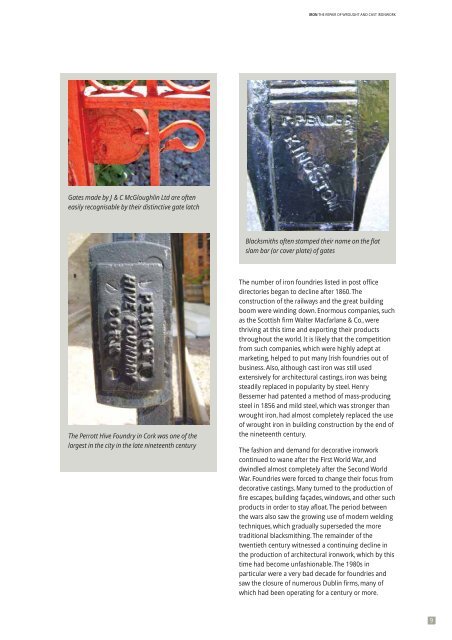The Repair of Wrought and Cast Iron Work - Dublin City Council
The Repair of Wrought and Cast Iron Work - Dublin City Council
The Repair of Wrought and Cast Iron Work - Dublin City Council
You also want an ePaper? Increase the reach of your titles
YUMPU automatically turns print PDFs into web optimized ePapers that Google loves.
IRON THE REPAIR OF WROUGHT AND CAST IRONWORK<br />
Gates made by J & C McGloughlin Ltd are <strong>of</strong>ten<br />
easily recognisable by their distinctive gate latch<br />
Blacksmiths <strong>of</strong>ten stamped their name on the flat<br />
slam bar (or cover plate) <strong>of</strong> gates<br />
<strong>The</strong> Perrott Hive Foundry in Cork was one <strong>of</strong> the<br />
largest in the city in the late nineteenth century<br />
<strong>The</strong> number <strong>of</strong> iron foundries listed in post <strong>of</strong>fice<br />
directories began to decline after 1860. <strong>The</strong><br />
construction <strong>of</strong> the railways <strong>and</strong> the great building<br />
boom were winding down. Enormous companies, such<br />
as the Scottish firm Walter Macfarlane & Co., were<br />
thriving at this time <strong>and</strong> exporting their products<br />
throughout the world. It is likely that the competition<br />
from such companies, which were highly adept at<br />
marketing, helped to put many Irish foundries out <strong>of</strong><br />
business. Also, although cast iron was still used<br />
extensively for architectural castings, iron was being<br />
steadily replaced in popularity by steel. Henry<br />
Bessemer had patented a method <strong>of</strong> mass-producing<br />
steel in 1856 <strong>and</strong> mild steel, which was stronger than<br />
wrought iron, had almost completely replaced the use<br />
<strong>of</strong> wrought iron in building construction by the end <strong>of</strong><br />
the nineteenth century.<br />
<strong>The</strong> fashion <strong>and</strong> dem<strong>and</strong> for decorative ironwork<br />
continued to wane after the First World War, <strong>and</strong><br />
dwindled almost completely after the Second World<br />
War. Foundries were forced to change their focus from<br />
decorative castings. Many turned to the production <strong>of</strong><br />
fire escapes, building façades, windows, <strong>and</strong> other such<br />
products in order to stay afloat. <strong>The</strong> period between<br />
the wars also saw the growing use <strong>of</strong> modern welding<br />
techniques, which gradually superseded the more<br />
traditional blacksmithing. <strong>The</strong> remainder <strong>of</strong> the<br />
twentieth century witnessed a continuing decline in<br />
the production <strong>of</strong> architectural ironwork, which by this<br />
time had become unfashionable. <strong>The</strong> 1980s in<br />
particular were a very bad decade for foundries <strong>and</strong><br />
saw the closure <strong>of</strong> numerous <strong>Dublin</strong> firms, many <strong>of</strong><br />
which had been operating for a century or more.<br />
9

















